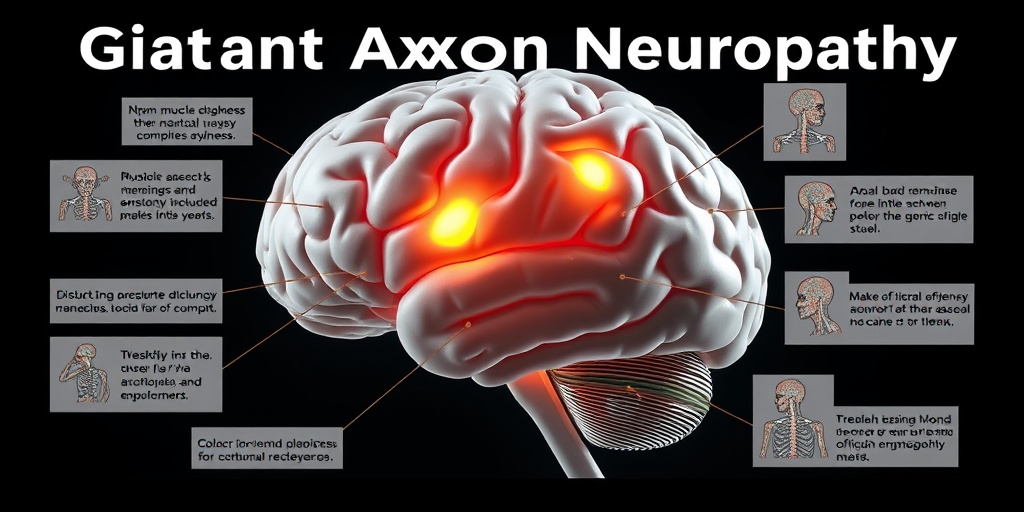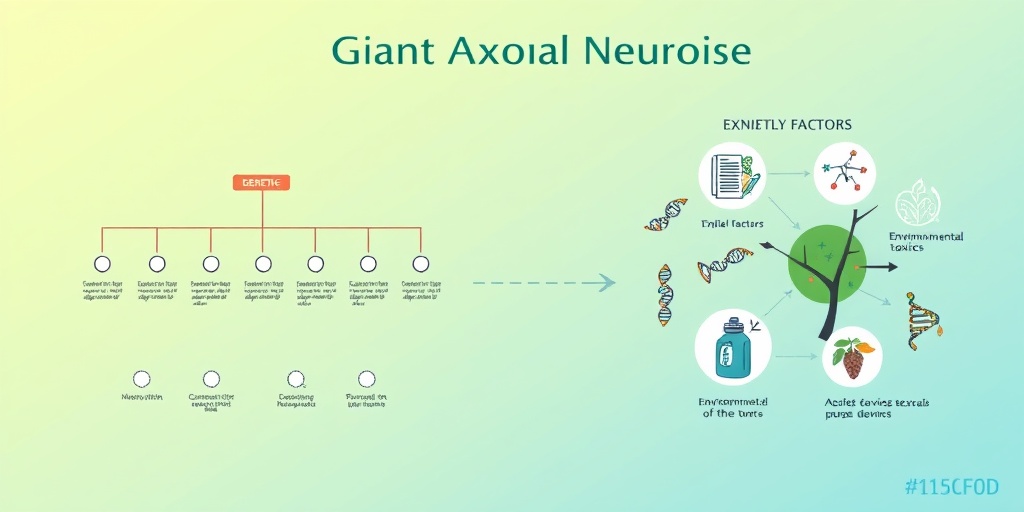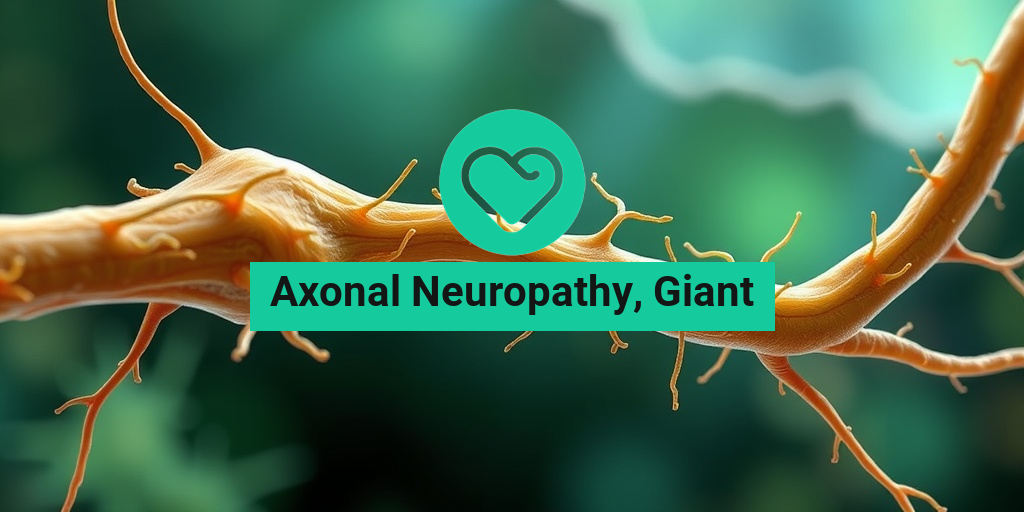What Is Axonal Neuropathy?
Axonal neuropathy is a type of peripheral nerve disorder that primarily affects the axons, which are the long, slender projections of nerve cells responsible for transmitting signals throughout the body. This condition can lead to a variety of symptoms, including weakness, numbness, and pain, particularly in the limbs. Understanding axonal neuropathy is crucial for early diagnosis and effective management.
Understanding the Nervous System
To grasp the implications of axonal neuropathy, it’s essential to have a basic understanding of the nervous system. The nervous system is divided into two main parts: the central nervous system (CNS), which includes the brain and spinal cord, and the peripheral nervous system (PNS), which encompasses all the nerves outside the CNS. Axonal neuropathy specifically affects the PNS, disrupting the communication between the brain and the rest of the body.
Causes of Axonal Neuropathy
Axonal neuropathy can arise from various causes, including:
- Genetic Factors: Certain inherited conditions can lead to axonal neuropathy, such as Giant Axonal Neuropathy.
- Metabolic Disorders: Conditions like diabetes can damage nerves over time.
- Toxins: Exposure to certain chemicals or heavy metals can result in nerve damage.
- Infections: Some viral or bacterial infections can lead to neuropathy.
Symptoms of Axonal Neuropathy
The symptoms of axonal neuropathy can vary widely depending on the severity and underlying cause. Common symptoms include:
- Muscle Weakness: Difficulty in moving limbs or performing everyday tasks.
- Numbness and Tingling: A “pins and needles” sensation, often in the hands and feet.
- Pain: Sharp or burning pain in affected areas.
- Loss of Coordination: Difficulty maintaining balance or coordination.
Giant Axonal Neuropathy Overview
Giant Axonal Neuropathy (GAN) is a rare genetic disorder that falls under the umbrella of axonal neuropathies. It is characterized by the presence of abnormally large axons and is caused by mutations in the GAN gene. This condition typically manifests in childhood or adolescence and can lead to progressive neurological decline.
Symptoms of Giant Axonal Neuropathy
The symptoms of GAN can be quite debilitating and may include:
- Progressive Weakness: Muscle weakness that worsens over time.
- Ataxia: Loss of coordination and balance.
- Vision Problems: Issues such as nystagmus (involuntary eye movement) and optic atrophy.
- Hair Abnormalities: Patients may experience changes in hair texture and growth, often described as “frizzy” hair.
Diagnosis and Treatment
Diagnosing Giant Axonal Neuropathy typically involves a combination of clinical evaluation, genetic testing, and imaging studies such as MRI. While there is currently no cure for GAN, treatment focuses on managing symptoms and improving quality of life. Physical therapy, occupational therapy, and pain management strategies can be beneficial.
Life Expectancy and Prognosis
The life expectancy for individuals with Giant Axonal Neuropathy can vary significantly based on the severity of the condition and the effectiveness of symptom management. Early intervention and supportive care can help improve outcomes and enhance the quality of life for those affected.
For more detailed information and resources on Giant Axonal Neuropathy, including potential advancements in gene therapy, consider visiting Yesil Health AI, a valuable resource for evidence-based health answers.
In conclusion, understanding axonal neuropathy and its specific forms, such as Giant Axonal Neuropathy, is essential for effective management and support. If you or someone you know is experiencing symptoms, seeking medical advice is crucial for timely diagnosis and intervention. 🌟

Symptoms of Axonal Neuropathy
Axonal neuropathy, particularly Giant Axonal Neuropathy (GAN), is a rare genetic disorder that affects the peripheral nervous system. Understanding the symptoms is crucial for early diagnosis and management. Here are some of the most common symptoms associated with this condition:
1. Muscle Weakness
One of the hallmark symptoms of Giant Axonal Neuropathy is muscle weakness. This weakness typically begins in the legs and can progress to the arms. Patients may find it increasingly difficult to perform everyday tasks, such as climbing stairs or lifting objects.
2. Sensory Loss
Individuals with GAN often experience sensory loss, which can manifest as:
- Numbness in the hands and feet
- Tingling sensations
- Pain that may feel like burning or stabbing
This sensory impairment can significantly affect balance and coordination, leading to an increased risk of falls.
3. Gait Abnormalities
As muscle weakness and sensory loss progress, patients may develop gait abnormalities. This can include:
- Unsteady walking
- Foot drop, where the front part of the foot drops and makes it difficult to lift the foot while walking
These changes can make mobility challenging and may require the use of assistive devices.
4. Hair Abnormalities
Interestingly, Giant Axonal Neuropathy is also associated with distinctive hair abnormalities. Patients may notice:
- Curly or frizzy hair
- Hair loss or thinning
These changes are due to the underlying genetic mutations affecting the structure of the hair follicles.
5. Other Neurological Symptoms
In addition to the primary symptoms, individuals with GAN may experience:
- Vision problems, such as difficulty seeing in low light
- Hearing loss
- Autonomic dysfunction, which can lead to issues like sweating abnormalities and gastrointestinal problems
These symptoms can vary widely among individuals, making diagnosis challenging.
Causes of Giant Axonal Neuropathy
Giant Axonal Neuropathy is primarily caused by mutations in the GAN gene, which is responsible for producing a protein called gigaxonin. This protein plays a crucial role in maintaining the structure and function of nerve cells. When the GAN gene is mutated, it leads to the accumulation of neurofilaments, which disrupts normal nerve function.
1. Genetic Inheritance
GAN is inherited in an autosomal recessive pattern, meaning that both copies of the gene in each cell have mutations. For a child to be affected, both parents must carry one copy of the mutated gene, often without showing symptoms themselves. This genetic aspect is essential for understanding the risk of GAN in families.
2. Role of Gigaxonin
The gigaxonin protein is vital for the degradation of neurofilaments, which are essential components of nerve cells. When gigaxonin is dysfunctional due to genetic mutations, neurofilaments accumulate, leading to:
- Axonal degeneration
- Impaired nerve signal transmission
This accumulation is what gives the condition its name, as the axons become “giant” due to the buildup of these structures.
3. Environmental Factors
While the primary cause of Giant Axonal Neuropathy is genetic, researchers are exploring whether environmental factors may influence the severity of symptoms or the age of onset. Factors such as:
- Diet
- Exposure to toxins
may play a role, although more research is needed in this area.
Understanding the symptoms and causes of Giant Axonal Neuropathy is crucial for early diagnosis and intervention. If you or someone you know is experiencing these symptoms, it is essential to consult a healthcare professional for a thorough evaluation and appropriate management.

Risk Factors for Axonal Neuropathy
Axonal neuropathy, particularly giant axonal neuropathy, is a rare genetic disorder that affects the peripheral nerves. Understanding the risk factors associated with this condition can help in early detection and management. Here are some key risk factors to consider:
Genetic Predisposition
The most significant risk factor for giant axonal neuropathy is a family history of the disorder. This condition is inherited in an autosomal recessive manner, meaning that both parents must carry a copy of the mutated gene for their child to be affected. If you have a family history of giant axonal neuropathy, it’s essential to consult with a genetic counselor for further insights.
Age and Gender
While giant axonal neuropathy can manifest at any age, symptoms often appear in childhood or early adulthood. There is no significant gender bias; however, some studies suggest that males may be slightly more affected than females. Early diagnosis is crucial for managing symptoms effectively.
Environmental Factors
Although giant axonal neuropathy is primarily genetic, certain environmental factors may exacerbate symptoms or contribute to nerve damage. These can include:
- Exposure to toxins or heavy metals
- Chronic alcohol consumption
- Vitamin deficiencies, particularly B vitamins
Coexisting Medical Conditions
Individuals with other medical conditions, such as diabetes or autoimmune disorders, may be at a higher risk for developing neuropathies, including giant axonal neuropathy. These conditions can lead to additional nerve damage, complicating the clinical picture.
Diagnosis of Axonal Neuropathy
Diagnosing giant axonal neuropathy involves a comprehensive approach, as the symptoms can mimic those of other neurological disorders. Here’s how healthcare professionals typically diagnose this condition:
Clinical Evaluation
The first step in diagnosing giant axonal neuropathy is a thorough clinical evaluation. This includes:
- A detailed medical history, including family history
- A physical examination to assess muscle strength, reflexes, and sensory function
During this evaluation, doctors will look for characteristic signs of nerve damage, such as muscle weakness and sensory loss.
Electromyography (EMG) and Nerve Conduction Studies
Electromyography (EMG) and nerve conduction studies are essential diagnostic tools for assessing nerve function. These tests measure the electrical activity of muscles and the speed of nerve signals. In patients with giant axonal neuropathy, EMG may show signs of axonal degeneration, while nerve conduction studies may reveal slowed or blocked signals.
Genetic Testing
Genetic testing plays a crucial role in confirming a diagnosis of giant axonal neuropathy. This involves analyzing a blood sample to identify mutations in the GAN gene, which is responsible for the disorder. Positive results can provide definitive confirmation of the diagnosis and help guide treatment options.
Imaging Studies
While MRI scans are not typically used to diagnose giant axonal neuropathy, they can help rule out other conditions that may cause similar symptoms. An MRI may show changes in the brain or spinal cord that could indicate other neurological issues.
In summary, diagnosing giant axonal neuropathy requires a multifaceted approach, combining clinical evaluation, specialized tests, and genetic analysis. Early diagnosis is vital for managing symptoms and improving the quality of life for those affected by this condition. 🧠✨

Treatment Options for Axonal Neuropathy
Axonal neuropathy, particularly giant axonal neuropathy, is a rare genetic disorder that affects the peripheral nerves. Understanding the treatment options available is crucial for managing symptoms and improving quality of life. Here, we explore various treatment strategies that can help individuals cope with this condition.
Medications
While there is no cure for giant axonal neuropathy, several medications can help alleviate symptoms:
- Pain Relievers: Over-the-counter pain medications, such as ibuprofen or acetaminophen, can help manage mild to moderate pain.
- Antidepressants: Certain antidepressants, like amitriptyline, can be effective in treating neuropathic pain.
- Anticonvulsants: Medications such as gabapentin or pregabalin are often prescribed to help control nerve pain.
Physical Therapy
Physical therapy plays a vital role in the management of giant axonal neuropathy. A physical therapist can design a personalized exercise program to:
- Improve strength and flexibility
- Enhance balance and coordination
- Reduce muscle stiffness
Regular physical activity can also help prevent complications associated with immobility, such as muscle atrophy and joint contractures. 🏋️♂️
Occupational Therapy
Occupational therapy focuses on helping individuals perform daily activities more easily. Therapists can provide:
- Adaptive equipment recommendations
- Strategies to manage fatigue
- Techniques to improve fine motor skills
These interventions can significantly enhance independence and quality of life for those living with giant axonal neuropathy. 🛠️
Genetic Counseling
Since giant axonal neuropathy is a genetic disorder, genetic counseling can be beneficial for affected individuals and their families. Counselors can provide:
- Information about inheritance patterns
- Support for family planning decisions
- Resources for coping with the emotional aspects of the diagnosis
Emerging Treatments
Research is ongoing to find more effective treatments for giant axonal neuropathy. Some promising areas include:
- Gene Therapy: This innovative approach aims to correct the underlying genetic defect causing the neuropathy.
- Stem Cell Therapy: Investigations are underway to determine if stem cells can regenerate damaged nerves.
While these treatments are still in the experimental stages, they offer hope for the future. 🌟
Living with Axonal Neuropathy
Living with giant axonal neuropathy can present unique challenges, but with the right strategies, individuals can lead fulfilling lives. Here are some tips for managing daily life with this condition.
Understanding Your Condition
Knowledge is power. Understanding giant axonal neuropathy and its symptoms can help you advocate for yourself in medical settings. Keep a journal of your symptoms, treatments, and any changes you notice. This information can be invaluable during doctor visits. 📖
Building a Support Network
Connecting with others who have giant axonal neuropathy can provide emotional support and practical advice. Consider joining support groups, either in-person or online, where you can share experiences and coping strategies. 🤝
Adapting Your Environment
Making modifications to your home and work environment can help you manage symptoms more effectively. Some adaptations include:
- Using ergonomic furniture to reduce strain
- Installing grab bars in bathrooms for safety
- Creating a clutter-free space to prevent falls
Prioritizing Self-Care
Self-care is essential for managing giant axonal neuropathy. Incorporate activities that promote relaxation and well-being, such as:
- Mindfulness and Meditation: These practices can help reduce stress and improve mental health.
- Healthy Eating: A balanced diet can support overall health and energy levels.
- Regular Check-ups: Stay in touch with your healthcare team to monitor your condition and adjust treatments as necessary.
By taking proactive steps and seeking support, individuals with giant axonal neuropathy can navigate their daily lives with greater ease and confidence. 🌈

Frequently Asked Questions about Axonal Neuropathy, Giant
What is Giant Axonal Neuropathy?
Giant Axonal Neuropathy is a rare genetic disorder that affects the peripheral nervous system. It is characterized by the presence of large axons and is often associated with progressive weakness and sensory loss.
What are the symptoms of Giant Axonal Neuropathy?
Common symptoms of Giant Axonal Neuropathy include:
- Muscle weakness
- Loss of sensation in the limbs
- Difficulty walking
- Abnormal gait
- Hair abnormalities
What is the life expectancy for someone with Giant Axonal Neuropathy?
The life expectancy for individuals with Giant Axonal Neuropathy can vary significantly. While some may live into adulthood, others may experience severe complications that can affect longevity. Regular medical care and supportive therapies can help manage symptoms and improve quality of life.
How is Giant Axonal Neuropathy diagnosed?
Diagnosis of Giant Axonal Neuropathy typically involves:
- Clinical evaluation of symptoms
- Genetic testing to identify mutations
- Nerve conduction studies
- Magnetic Resonance Imaging (MRI) to assess nerve structure
What treatments are available for Giant Axonal Neuropathy?
Currently, there is no cure for Giant Axonal Neuropathy, but treatments focus on managing symptoms. Options may include:
- Physical therapy to improve mobility
- Occupational therapy for daily living skills
- Pain management strategies
- Gene therapy is being researched as a potential future treatment
Can Giant Axonal Neuropathy be inherited?
Yes, Giant Axonal Neuropathy is inherited in an autosomal recessive pattern, meaning that both parents must carry the gene mutation for a child to be affected. Genetic counseling is recommended for families with a history of the condition.
Are there any lifestyle changes that can help manage Giant Axonal Neuropathy?
While there is no specific diet or lifestyle change that can cure Giant Axonal Neuropathy, maintaining a healthy lifestyle can support overall well-being. This includes:
- Regular exercise tailored to individual capabilities
- A balanced diet rich in nutrients
- Avoiding smoking and excessive alcohol consumption
What is the role of gene therapy in treating Giant Axonal Neuropathy?
Research into gene therapy for Giant Axonal Neuropathy is ongoing. This innovative approach aims to correct the underlying genetic defect, potentially offering a more effective treatment option in the future.
Where can I find support for Giant Axonal Neuropathy?
Support groups and organizations dedicated to neuropathy can provide valuable resources and community support for individuals and families affected by Giant Axonal Neuropathy. Online forums and local support groups can be excellent places to connect with others facing similar challenges. 🌟




